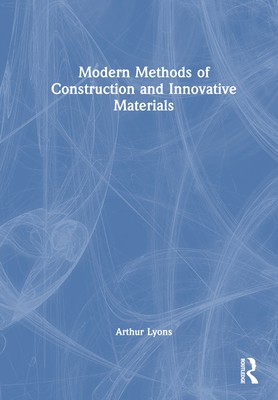
- We will send in 10–14 business days.
- Author: Arthur Lyons
- Publisher: Routledge
- ISBN-10: 1032419342
- ISBN-13: 9781032419343
- Format: 17 x 24.4 x 1.6 cm, kieti viršeliai
- Language: English
- SAVE -10% with code: EXTRA
Modern Methods of Construction and Innovative Materials (e-book) (used book) | bookbook.eu
Reviews
Description
This new textbook has two main themes. The first is Modern Methods of Construction (MMC) which is the off-site manufacture of a wide spectrum of products, ranging from whole buildings to be transported onto site, down to smaller units or components for site integration. The second theme is describing the wide range of developing products for the construction industry, many of which are being developed for environmental reasons.
The first section of the book describes and illustrates with photographs, the major forms of Modern Methods of Construction. These include fully completed 3D units, panelised systems, pods, sub-assemblies and on-site MMC. The section on Innovative Materials then describes a wide range of construction products which are entering into the built environment sector. Some new entrants are variants on well-established construction materials such as steel and concrete. Materials such as these will remain major construction materials for the foreseeable future, but their composition and manufacturing processes will inevitably have to change. Timber also will remain a major construction material, but sustainable sourcing is key and its utilisation as cross-lamination timber (CLT) or as modified timber is rapidly developing. As a result, students and practitioners must familiarise themselves with these materials, their composition, and various uses.
The book goes on to cover many traditional products, such as glass, plastic and insulation, which are undergoing major developments leading towards enhanced environmental control. The final chapter includes some emerging materials such as graphene and carbon fibre which only a few years ago, would not have been considered for use in the industry, but are likely to be significant in future.
This book is the only book combining these important elements of the future of the industry in an easy-to-read guide for students and new practitioners. It is essential reading for anyone studying and working in the built environment, be they architects, construction managers, surveyors, or engineers.
EXTRA 10 % discount with code: EXTRA
The promotion ends in 22d.11:59:52
The discount code is valid when purchasing from 10 €. Discounts do not stack.
- Author: Arthur Lyons
- Publisher: Routledge
- ISBN-10: 1032419342
- ISBN-13: 9781032419343
- Format: 17 x 24.4 x 1.6 cm, kieti viršeliai
- Language: English English
This new textbook has two main themes. The first is Modern Methods of Construction (MMC) which is the off-site manufacture of a wide spectrum of products, ranging from whole buildings to be transported onto site, down to smaller units or components for site integration. The second theme is describing the wide range of developing products for the construction industry, many of which are being developed for environmental reasons.
The first section of the book describes and illustrates with photographs, the major forms of Modern Methods of Construction. These include fully completed 3D units, panelised systems, pods, sub-assemblies and on-site MMC. The section on Innovative Materials then describes a wide range of construction products which are entering into the built environment sector. Some new entrants are variants on well-established construction materials such as steel and concrete. Materials such as these will remain major construction materials for the foreseeable future, but their composition and manufacturing processes will inevitably have to change. Timber also will remain a major construction material, but sustainable sourcing is key and its utilisation as cross-lamination timber (CLT) or as modified timber is rapidly developing. As a result, students and practitioners must familiarise themselves with these materials, their composition, and various uses.
The book goes on to cover many traditional products, such as glass, plastic and insulation, which are undergoing major developments leading towards enhanced environmental control. The final chapter includes some emerging materials such as graphene and carbon fibre which only a few years ago, would not have been considered for use in the industry, but are likely to be significant in future.
This book is the only book combining these important elements of the future of the industry in an easy-to-read guide for students and new practitioners. It is essential reading for anyone studying and working in the built environment, be they architects, construction managers, surveyors, or engineers.


Reviews